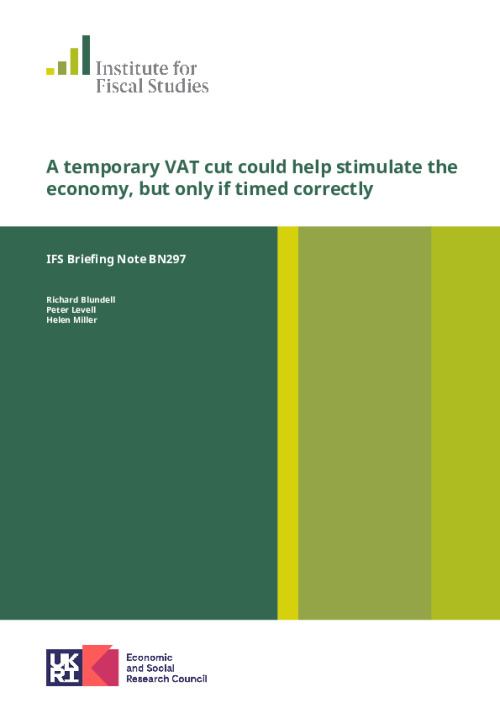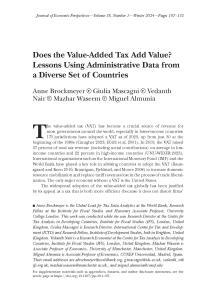Reports indicate the government is considering a temporary cut in VAT to stimulate consumer demand, possibly targeted at sectors such as tourism and restaurants.
A temporary VAT cut has the advantage that it is a ‘shovel-ready’ measure, which is easy to implement quickly. It can provide a short-term boost to the economy by giving people more money to spend and by incentivising consumers to bring purchases forward to take advantage of temporarily lower prices
At the moment, supply is still restrained by social distancing measures and it is not clear yet how much stimulus will be needed when consumers are able to spend more freely.
A temporary VAT cut would be most effective as a stimulus: i) when we are confident social distancing measures will continue to be eased and that these measures are no longer limiting supply; ii) when firms that would be affected by the cut are able to accommodate additional demand and are likely to respond by passing a VAT cut onto prices; iii) when uncertainty and fear of the virus is lower so that consumers would be willing to increase spending; iv) if demand is still low even when these other conditions hold.
These conditions are not met now, but it is possible they will be met in the near future. The government should carefully assess the situation over the coming weeks. The government should certainly not preannounce a VAT cut because that would lead consumers to delay purchases to when the cut comes into effect (in fact, speculation about a cut could depress current sales). If a cut is enacted, its expiration should be timed to coincide with, or made conditional on, a return to sustained economic growth, so as not to choke off a nascent recovery.
The economy won’t bounce back on its own
It is natural for the government to be considering a fiscal stimulus. The UK is currently in the grip of the sharpest economic contraction since records began, and there is extremely limited scope for further interest rate cuts to help support the economy. As well as its sheer scale, this recession is unusual in that it is largely the result of deliberate shutdowns of certain sectors for the sake of public health. Household consumption spending has fallen precipitously, but this is mainly because some goods and services have not been available over the past few months.[1] As the economy reopens, a large proportion of that demand will come back. Some households have been effectively forced to save during the lockdown and there may even be some pent-up demand for goods and services they cannot currently buy (such as travel and restaurant meals). However, three factors in particular mean the economy is unlikely to simply bounce back to its pre-crisis state once social distancing measures are ended. First, many consumers have seen large falls in their incomes, forcing them to either borrow or use their savings. These households are likely to continue to limit spending even as lockdown is eased. Second, continued uncertainty surrounding health and the economy is likely to suppress both consumption and investment for the foreseeable future. Third, spending and working patterns are likely to be different for some time and in some cases perhaps permanently. Some jobs lost during the pandemic will never come back, while new jobs in other sectors will take time to appear and new worker-firm matches will take time to form. The nature and scale of any stimulus measures must account for these different factors and how they play out in the coming months.
A VAT cut could stimulate spending…
A temporary VAT cut could be used to stimulate demand if economic growth remains weak after social distancing measures are eased. Relative to some other forms of stimulus, a VAT cut is quick to implement. There is also evidence that cutting VAT has been effective at stimulating consumer demand in the past; a temporary VAT cut was in place from December 2008 until December 2009 and succeeded in boosting consumer sentiment and retail sales.[2]
Temporary VAT cuts stimulate consumer purchases by reducing the post-tax prices individuals pay for goods and services. This in turn increases consumers’ purchases of goods through two channels.
- Firstly, there is an income effect. Put simply, by reducing consumers’ bills, a VAT cut puts money in their pockets. To the extent consumers use these funds to make additional purchases, this stimulates spending and economic activity. They may of course also save any windfall or use it to pay down debts.
- Secondly, there is a substitution effect. Households have an incentive to bring forward purchases to take advantage of lower prices when the VAT cut is in effect. This leads to a temporary boost to demand. We would expect this effect to be particularly large for spending on durable goods such as cars or TVs, or other non-perishable goods that consumers can stock-up on.
These two forces boost output through a multiplier effect. Greater purchases during the period of the VAT cut leads to more work for those producing that output, and in turn higher employment and earnings, which in turns leads to greater spending, and so on. This would be especially valuable at a time when unemployment is relatively high and much of the workforce remains on furlough.
…but past success does not necessarily make it an appropriate tool for the current crisis
There are a number of reasons why a temporary VAT cut may be less effective in the current crisis. A key consideration is how much of the forgone revenue from the VAT cut leads to more purchases (and therefore output) and how much is saved, or spent on imports in a way that does not boost short-term UK output and employment.
- Since the stimulus relies on firms’ actually reducing prices, the ‘pass-through’ of the tax cut to consumer prices is crucial. The 2008 temporary VAT cut led to a substantial reduction in consumer prices.[3] Whether this would be true in the current situation is unclear and may vary by sector. Some firms may have limited ability to meet increases in demand if supply chains are disrupted and social distancing makes it difficult to take on new staff (or even to reinstate previous staff).[4] Until these supply constraints ease, these firms will be less likely to cut the prices they charge consumers if VAT rates fall. Other firms may have difficulty clearing old stock or attracting customers and may be able to hire or recall additional worker easily. These firms would be more likely to pass through price reductions to consumers.
- The size of the income effect will depend on the degree to which consumers save or spend any additional funds. Continued fear of the virus and its longer-run impact on the economy may depress consumers’ responsiveness to price falls.
- The size of the substitution effect in particular depends on uncertainty. In an uncertain economic climate, consumers are likely to be particularly careful about purchasing expensive durable goods (such as cars or fridges). This will dampen the stimulus effect of a VAT cut by making consumers reluctant to bring forward purchases. Uncertainty over future economic conditions is likely to be an important consideration for the coming months. The increase in measures of uncertainty following the COVID-19 pandemic are greater in magnitude than they were following the 2008 financial crisis.[5]
- Even without a stimulus, we expect an increase in consumer demand as more parts of the economy are opened. If purchases would rebound towards more normal levels even without stimulus, cutting VAT would lead to a large amount of deadweight – i.e. the government would be cutting taxes on purchases that would have happened anyway.
It might be a better idea at a later date
All of these issues point to the importance of getting the timing of a VAT cut right. A VAT cut would have only limited effect if introduced at a time when many consumer products are unavailable and uncertainty remains high. Since a temporary VAT cut can be implemented relatively quickly, the government is perhaps better off taking a wait-and-see approach: waiting to see how quickly consumer spending recovers over the coming weeks as fears of the virus recede before deciding whether and how to implement it.
If the government does decide to cut VAT temporarily then it should also announce how the policy will be ended. Consumers will only bring forward purchases if they expect VAT rates to rise back to where they were again (or higher) in a relatively short period of time. The expiration of the temporary cut needs to be carefully timed to take place only after economic growth has resumed.
Targeting a cut
Media reports suggest the government is also considering a VAT cut targeted in particular at the hospitality and tourism sectors. One potential advantage of this approach is that it’s more likely to encourage purchases of goods and services provided by firms in the UK, avoiding a situation where stimulus spending ‘leaks’ abroad through higher spending on imports (for example imported consumer durables). These sectors are also more likely to report having reduced prices in recent weeks, suggesting deficient demand and a greater chance they will pass price reductions through to consumers.[6] A significant disadvantage is that gains from such a targeted stimulus would be likely to go to higher-income households, who spend a larger share of their income on such goods and services in normal times, and who are much more likely to save – rather than spend - any additional funds. The income effect associated with this kind of targeted cut would therefore likely be small. Since these goods are less easy to ‘stock up on’, the substitution effect may be smaller too.
Overall the case for a temporary VAT cut now is mixed. Such a policy could provide an important fillip to consumer demand if introduced at the right time, but there are a number of reasons to believe it would be less effective in the current recession– especially if it is implemented too early. The government has a range of other stimulus levers that it would be sensible to use soon, including investing in training and infrastructure to directly promote employment and boost future productivity.
[1] See Sinem Hacioglu, Diego R Känzig and Paolo Surico (2020), “Consumption in the time of COVID-19: Evidence from UK transaction data” CEPR DP No. 14646 https://cepr.org/content/free-dp-download-14-may-2020-consumption-time-covid-19-evidence-uk-transaction-data
[2] Janjala Chirakijja, Thomas Crossley, Melanie Lührman and Cormac O’Dea (2009) “The Stimulus Effect of the 2008 UK Temporary Vat Cut” National Tax Association Proceedings and Thomas Crossley, Hamish Low and Cath Sleeman (2014), “Using a Temporary Indirect Tax Cut as a Fiscal Stimulus: Evidence from the UK”, IFS Working Paper W14/16. Institute for Fiscal Studies, London.
[3] Chirakijja et al. (2009) op cit.
[4] For example, in May 60% of firm that changed their imports during the pandemic reported challenges importing due to COVID related transport restrictions, importing goods due to COVID related transport restrictions, increases in transport costs, closure of infrastructure or border restrictions in the past 2-weeks. 5.5% of firms reported not being able to source the goods and materials they needed from within the UK. See the results from Office for National Statistics (2020), ‘Coronavirus and the latest indicators for the UK economy and society : 18 June 2020’ https://www.ons.gov.uk/economy/economicoutputandproductivity/output/datasets/businessimpactofcovid19surveybicsresults
[5] Scott Baker, Nick Bloom, Steven Davis and Stephen Terry (2020), ‘COVID-induced economic uncertainty and its consequences’, VoxEU.org, 13 April. https://voxeu.org/article/covid-induced-economic-uncertainty-and-its-consequences
[6] For instance, 12.1% and 7.9% of businesses in the accommodation and food service, and arts, entertainment and recreation sectors respectively reported reducing prices in the last two weeks of May (just 1.8% and 2.2% of firms in these two sectors reported increasing prices). See results from Office for National Statistics (2020), ‘Coronavirus and the latest indicators for the UK economy and society : 18 June 2020’ https://www.ons.gov.uk/economy/economicoutputandproductivity/output/datasets/businessimpactofcovid19surveybicsresults













